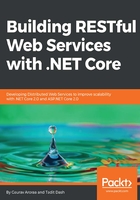
Client-server architecture
The client or the consumer of the service should not worry about how the server processes the data and stores it in the database. Similarly, the server does not need to depend on the client's implementation, especially the UI.
Think of an internet of things device or sensor that doesn't have much of a UI. However, it interacts with the server to store data using APIs, which are programmed to be fired on specific events. Suppose you are using an IoT device that alerts you when your car runs out of petrol. At the time of a petrol shortage detection by the sensor in the IoT device, it calls the configured API, which then finally sends an alert to the owner.
What that means is that the client and server are not one entity and each can live without the other. They can be designed and evolved independently. Now you might ask, How can a client work without knowing about the server's architecture, and vice versa? Well, that is what these constraints are meant for. The service, when interacted with by the clients, provides enough information about its nature: how to consume it, and what operations you can carry out using it.
As we go ahead in this section, you will realize that there is absolutely no relation between the client and the server, and they can be completely decoupled if they adhere to all these constraints perfectly.